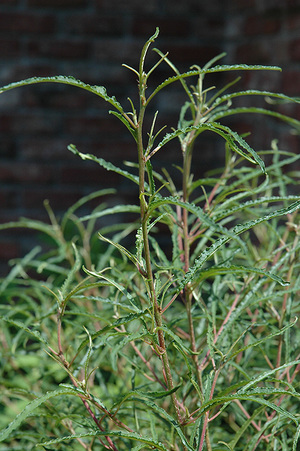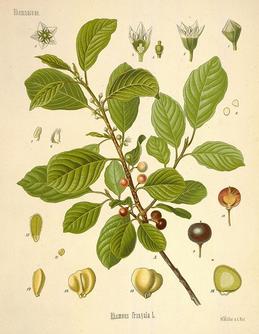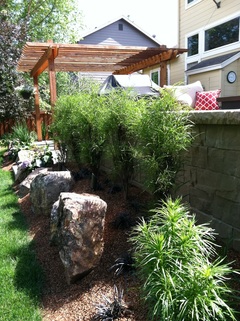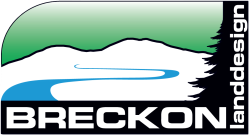|
Driving around town lately I’ve noticed more and more Buckthorn in the urban landscape. Not the classic Tallhedge Buckthorn I remember from my university days, when there were few choices for cold-hardy shrubs that held to a narrow form, but a new lance-leaf variety that offers an interesting alternative for hedges, screens, and vertical accents. My recollection of the ‘Columnaris’ version of this plant was of an upright shrub with nondescript but evidently compelling blossoms that attracted a daunting number of bees when they came on. Indeed, this transformed the hedgerow along the entry walk to the Fine Arts Building at Utah State into a buzzing gauntlet that was definitely not for the apiphobic -- that is, anyone with a fear of bees (or allergy thereto). In contrast, this new-ish cultivar blooms and fruits only minimally, is lauded as a low-maintenance addition to the landscape, and adds much textural interest to your plant design palette.  Foliage detail - Fine Line Buckthorn Foliage detail - Fine Line Buckthorn Botanical Name: Rhamnus frangula “Fine Line” USDA Hardiness Zone: 3-7 Extremely cold hardy to -50 degrees F. Flower: Insignificant, tiny (1/6” diameter). Cream-to-yellowish-green blossoms appear late May to early June. Fruit Production: Low. Negligible. Any seeds produced are typically non-viable. Leaves: Fine Line is a marvelous foliage plant. Narrow leaves result in a fine, feathery appearance. Lighter leaf color offers contrast to the deeper green of some other shrubs. Deciduous foliage turns bright yellow in the fall. Sun: Part to full sun. Water: Medium water use. Adaptable. Prefers well-drained soil. Size/Habit: 5 – 7’ high with a narrow, 1.5-2’ spread. History Glossy Buckthorn, one of the parents of ‘Fine Line,’ was first introduced to the United States from Europe about two hundred years ago. This plant’s primary appeal was cold hardiness. It was first envisioned as an ornamental shrub that could survive the harsh winters in and around the Great Lakes Region. In actuality, it turned out to be more adaptable than ornamental, and eventually ‘escaped’ into the upper Midwestern US and parts of Canada. Two cultivars emerged from this original introduction: ‘Columnaris,’ or the above-mentioned Tallhedge Buckthorn -- a fastigiate form that was widely used in the 1960s and 70s; and also the willowy-leafed “Asplenifolia” which took a rounded form, but with prettier foliage. In 1989, Ron Williams, a nurseryman in Green Bay, Wisconsin, discovered a unique seedling born of an accidental cross between the abovementioned buckthorn cultivars growing in his garden. Over the next decade, the plant was propagated by cuttings and developed for commercial distribution. In 2003, Mr. Williams licensed the plant patent to Spring Meadows Nursery in Michigan. Since then the Fine Line Buckthorn has been distributed nationally and continues to grow in popularity.  Human-Plant Interactions: Practical ▪ Symbolic ▪ Medicinal The Buckthorn story proves more interesting with the species, not the cultivars, so we’re looking up the family tree (pun intended) for this section: A cathartic experience. In medicine, Rhamnus frangula was historically used an as herbal supplement to relieve constipation. Typically administered as a tincture made from the bark or berries of the plant, it was best aged for a couple of years so as to reduce potency. Please note this antiquated remedy is not one we (or any true medical professional) would recommend today. Dyed in the wool. The bark and leaves of the Buckthorn species yield a yellow dye much used in Russia. When mixed with salts of iron, this same dye turns black. Indeed, the various parts of this plant display vast multi-chromatic potential. Unripe berries make a green-colored dye, readily taken by “woollen stuffs,” according to the literature. Alternately, ripe berries result in variable shades of blue and grey. Gunpowder, anyone? Once the bark is removed from Buckthorn stems and branches, the wood can be used to make charcoal with light, inflammable qualities that are far preferable to charcoal derived from other species. Gunpowder makers (doubtless a more exciting, if dangerous, profession than landscape architecture) sometimes refer to Buckthorn as ‘Black Dogwood.’ In Germany, it’s called Pulverholz, or ‘powder wood,’ for the same reason. Care ▪ Propagation ▪ Pests: By all accounts, Buckthorn is a low-maintenance choice, with no serious leanings towards disease or insect troubles. The Missouri Botanical Garden website describes Fine Line as a “restrained and versatile columnar accent.” That is, it tends to hold its narrow form naturally, without significant need for pruning.  Fine Line Buckthorn Hedge in a recent BLD residential design Fine Line Buckthorn Hedge in a recent BLD residential design It’s deer resistant, too? One source claims that Fine Line is unappetizing to free-ranging ungulates like deer. A notable asset to be sure, but I’m inclined to be wary. Depending on the year, this might be more or less true of many plants. This plant sounds FABULOUS… Is there a downside? The species (Rhamnus frangula) can be weedy and self-seeding in some areas. In fact, it's actually illegal to plant in a number of midwestern states. The Fine Line cultivar, however, is non-invasive and minds its Ps & Qs quite nicely in our arid climate, thanks in part to non-viable seeds. In all, Fine Line Buckthorn is still a relative newcomer, but has earned a reputation as a tough, adaptable plant, one that's well worth trying in your own landscape. Posted by Kim Warren
1 Comment
Jeff Dunaway
6/9/2023 11:05:39 am
How do I propagate rhamnus frangula...fine line
Reply
Leave a Reply. |
AuthorsArchives
January 2017
Categories |
Portfolio |
|

 RSS Feed
RSS Feed
